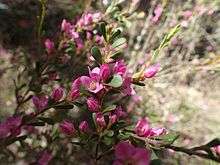Boronia crenulata
| Aniseed boronia | |
|---|---|
 | |
| Boronia crenulata leaves and flowers | |
| Scientific classification | |
| Kingdom: | Plantae |
| (unranked): | Angiosperms |
| (unranked): | Eudicots |
| (unranked): | Rosids |
| Order: | Sapindales |
| Family: | Rutaceae |
| Genus: | Boronia |
| Species: | B. crenulata |
| Binomial name | |
| Boronia crenulata Sm.[1] | |
| Synonyms | |
Boronia crenulata, commonly known as aniseed boronia, is a plant in the citrus family Rutaceae and is endemic to the south-west of Western Australia. It is an open-branched shrub, often trailing between other plants, has strap-like leaves and pink to purple-red, four-petalled flowers in winter and autumn.
Description
Boronia crenulata is a shrub which grows to a height of about 0.25–1.2 m (0.8–4 ft) and has weak, thin stems which often trail between other plants. The leaves are variable in shape, sometimes even on one plant, but in general are about 20 mm (0.8 in) long and 2 mm (0.08 in) wide, strap-like or egg-shaped with the narrower end towards the base. There are usually a few long soft hairs on the leaves and the margins of the leaves usually have a few small teeth.[2][3][4]
The flowers are pink to reddish and are scattered singly or in small groups in leaf axils or at the ends of the stems.The flowers are about 1 cm (0.4 in) in diameter on a stalk 4 mm (0.2 in) long. The sepals are egg-shaped to triangular, 1.5–2 mm (0.06–0.08 in) long and usually have a sharp, pointed tip. There are four glabrous petals and eight stamens.[2][3][4]
Taxonomy and naming
Boronia crenulata was first formally described in 1807 by James Edward Smith and the description was published in Transactions of the Linnean Society of London.[1][5] The specific epithet (crenulata) is derived from the Latin word crena meaning "a notch or rounded projection"[6] referring to the teeth on the leaf margins.[3]
There are four subspecies:
- Boronia crenulata subsp. crenulata;
- Boronia crenulata subsp. obtusa;
- Boronia crenulata subsp. viminea;
- Boronia crenulata subsp. pubescens.
Distribution and habitat
This boronia occurs in a broad area of the south-west of Western Australia in the Avon Wheatbelt, Esperance Plains, Geraldton Sandplains, Jarrah Forest, Mallee, Swan Coastal Plain and Warren biogeographic regions. It grows in a range of soils, from clay to limestone and from swampy coastal areas to the margins of salt lakes and rocky outcrops.[4]
Conservation
Boronia crenulata is listed as "not threatened" by the Government of Western Australia Department of Parks and Wildlife.[4]
References
- 1 2 "Boronia crenulata". APNI. Retrieved 22 October 2016.
- 1 2 Wilson, Paul G. (1998). "New names and new taxa in the genus Boronia (Rutaceae) from Western Australia, with notes on seed characters". Nuytsia. 12 (1): 123–126.
- 1 2 3 Marshall, John; Wilson, Margaret; Tullis, Brian (1990). Wildflowers of the West Coast Hills Region : the plants and flowers of the Darling Scarp and Range in the Kalamunda Shire, the backdrop to Perth, Western Australia (2002 (revised) ed.). Western Australia: Quality Publishing Australia. p. 64. ISBN 1875737243.
- 1 2 3 4 "Boronia crenulata". FloraBase. Western Australian Government Department of Parks and Wildlife.
- ↑ Smith, James Edward (1807). "Characters of Three New Species of Boronia.". Transactions of the Linnean Society of London. 8 (28): 284. Retrieved 22 October 2016.
- ↑ Brown, Roland Wilbur (1956). The Composition of Scientific Words. Washington, D.C.: Smithsonian Institution Press. p. 562.